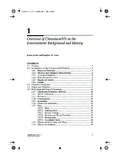Transcription of Nitric Acid - Jacobs Engineering Group
1 2013, Chemetics Inc. All rights acid ConcentrationBoth the single step evaporators and the distillation process utilize the Chemetics natural circulation thermosyphon evaporators that have proven to be extremely reliable and easy to operate. Gravity flow is used to transport the hot Nitric acid between the different concentration steps wherever possible to improve plant safety. Heat integration (feed/product interchangers) and high efficiency distillation tower packing (to minimize the amount of reflux) are used to reduce the energy requirements of the Nitric acid streams containing Nitrous acid (HNO2) or NOx are pre-treated in a purification column upstream of the concentration system. The NOx vapours from this column can be recovered as additional Nitric acid using a NOx options to remove other impurities ( dissolved solids) from the Nitric acid can be incorporated as acid is used in a wide variety of chemical processes.
2 Concentration of Nitric acid is complicated by the fact that Nitric acid has a maximum azeotrope at ~67wt% as shown in the chart Nitric acid ConcentrationDilute Nitric acid can be concentrated by evaporation of the water from the mixture. The maximum concentration that can be achieved for this two-component distillation process is the azeotrope concentration of ~67 wt%. Depending on the application Chemetics offers the following processes: Single step concentration under vacuum for product concentrations below 25 wt% Nitric acid Distillation at atmospheric pressure for product concentrations up to 67wt% Double effect concentration systems with improved energy consumption combining the single step vacuum concentration unit with the atmospheric distillation unit.
3 This process is expecially suitable for concentration of very dilute or very large streams of Nitric acid . 2013, Chemetics Inc. All rights Inc. Phone: +1 604 734 1200 Suite 200 2930 Virtual Way Fax: +1 604 734 0340 Vancouver, British Columbia, Canada V5M 0A5 Email: Nitric acid ConcentrationFor a significant number of chemical processes, the azeotrope concentration of 67 wt% is not sufficient and the Nitric acid has to be concentrated further. Due to the presence of the azeotrope, it is not possible to use a simple distillation system. Furthermore, the azeotrope concentration does not change significantly at different pressures and a dual pressure distillation ( , used for HCl concentration) does not provice a , the vapour pressure of the H2O-HNO3 system has to be manipulated to change the location of the azeotrope.
4 This can be done by adding a third component to the mixture. This additional chemical must be chosen carefully. Not only should this chemical have a significant effect on the Nitric acid VLE, it must also have a low vapour pressure, exhibit low toxicity and be stable at the temperatures in the distillation column. Both Sulphuric acid and Magnesium Nitrate satisfy these requirements and are commonly used. The next graph shows how the H2O-HNO3 equilibrium curve changes when Sulphuric acid is added into the mixture. It is clear that adding ~50 wt% sulphuric acid will be sufficient to achieve the desired effect of eliminating the azeotrope completely. Adding Magnesium Nitrate has the same is able to offer processes for the concentration of Nitric acid using either Sulphuric acid (NAC-SA) or Magnesium Nitrate (NAC-MG).
5 The heart of the process, the Nitric acid distillation column, is the same for both options; Weak Nitric acid and strong sulphuric acid are fed to the middle (also called the mixing section) of the column in such a proportion that the vapours leaving this section contain at least 80 wt% Nitric acid . This vapour is then further concentrated in the rectification section (top part of the column) until the desired concentration (typically 98-99 wt%) is reached. The liquid leaving the mixing section contains residual Nitric acid which is removed in the stripping section. Heat is supplied to the column using a reboiler located at the bottom of the stripping section. Some of the Nitric acid decomposes to NOx. This NOx leaves the top of the column with the Nitric acid vapour.
6 When the Nitric acid vapour is condensed, some of the NOx will condense giving the Nitric acid an orange/brown colour. If this NOx content can not be tolerated in the downstream process, a bleach column using air is added after the Nitric acid condenser to remove the NOx and produce a clear product. The NOx produced in the column is recovered as weak Nitric acid in the NOx absorption system and returned to the Nitric acid distillation column. The water removed from the weak Nitric acid is transferred to the magnesium nitrate or sulphuric acid solution and leaves the bottom of the column. After re-concentration in a vacuum evaporator the solution is re-used. Various options exist for achieving increased energy efficiency. We will be glad to help you choose.





